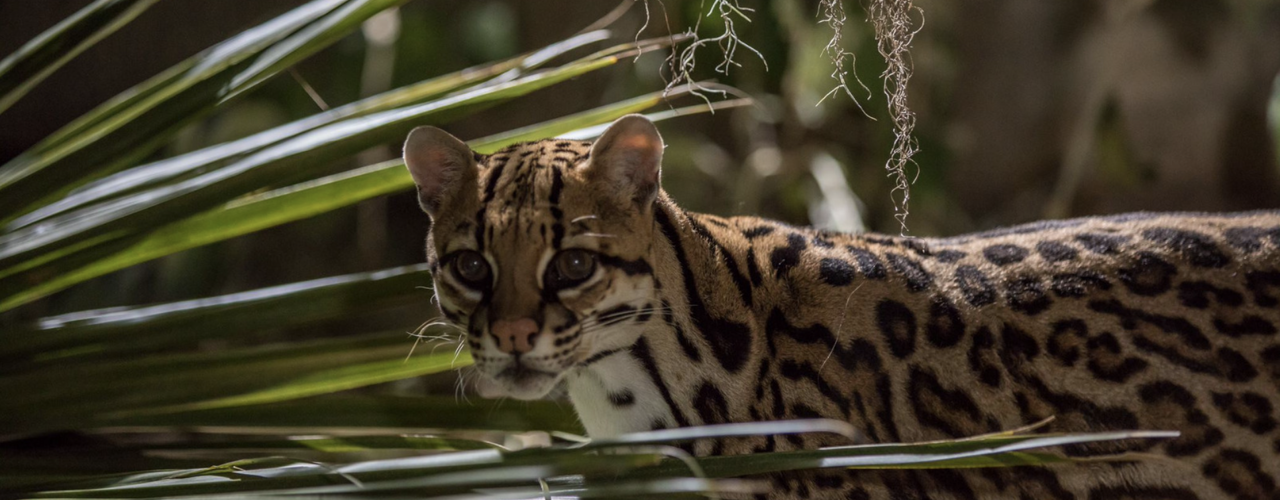

Study investigates reintroduction of ocelots to native Texas range
The Texas A&M Natural Resources Institute, a unit of Texas A&M Agrilife, in partnership with East Foundation, the Caesar Kleberg Wildlife Research Institute, Lindner Center for Conservation and Research of Endangered Wildlife at the Cincinnati Zoo, the University of Tennessee Comparative and Experimental Medicine Program and Center for Wildlife Health, Texas Parks and Wildlife Department, and the U.S. Fish and Wildlife Service, is launching a project to study the viability of potential actions designed to establish a new population of ocelots (Leopardus pardalis) in South Texas to both help prevent their extirpation and increase their numbers in the U.S.
Through this project, officially called “Developing and Assessing Strategies for Reintroducing Ocelots to Historical Texas Habitat,” the seven partners are exploring the feasibility of reintroducing the endangered ocelot to a portion of their historical range in Texas that is distinct from known populations’ currently occupied habitat.
The project’s exploratory research efforts include 1) assessments of where ecologically and socio-politically suitable ocelot habitat may occur in South Texas (and thus where possible reintroduction sites may occur), 2) the methods for sourcing individuals for an additional population of ocelots, 3) strategies for successfully releasing ocelots into the wild, 4) development of plans for the long-term management of reintroduced ocelots, and, 5) determining the long-term viability of a reintroduced population given ecological constraints.
“Historically, we found that the ocelots’ range in the U.S. extended throughout Arizona, Texas, Arkansas, and Louisiana,” said Dr. Roel Lopez, director of the Texas A&M Natural Resources Institute. “Over the years, however, historic overexploitation from unregulated hunting and trapping plus destruction or loss of habitat left ocelots vulnerable. Now, as we’ve discovered, resident breeding ocelots in the U.S. number fewer than 100 in the wild, making this exploratory process critical.”
With policy initiatives led by the U.S. Fish and Wildlife Service, the partners will incorporate the results of this research effort into consideration of options like the Endangered Species Act (ESA) 10(j) rule or Safe Harbor Agreement that would allow ocelot recovery efforts to move forward, including reintroductions, while also protecting the rights and interests of private landowners.
After assessing these research results and exploring different ESA regulatory possibilities, the project partners, representing government agencies, non-governmental organizations, and academic institutions, may propose to pursue actual ocelot reintroduction.
“Given the strong desire to provide regulatory relief and assurances to landowners, we anticipate a possible reintroduction proposal would be subject to a U.S. Fish and Wildlife Service rulemaking or permitting process. Either tool would include the opportunity for public comment and will include an extensive coordination effort with landowners interested in participating in ocelot reintroduction efforts,” said East Foundation CEO Neal Wilkins.
Ultimately, an ocelot reintroduction would be aimed at contributing to ocelot recovery under the ESA. Creating a new population of ocelots in Texas would increase the total number of wild, resident ocelots in the state, grow ocelots’ current range, and expand the genetic diversity of ocelots in Texas.
The project is currently only exploring scientific material and existing ocelot research to assess paths forward for ocelot conservation. No decision-making on ocelot reintroduction is occurring at this time.
“Prior to any decision to proceed with a proposal for reintroduction, the partners will conduct an extensive public outreach effort to identify and address potential concerns regarding a reintroduction effort and to ensure landowner coordination, engagement, and, hopefully, support,” said Brittany Wegner, a project specialist with the Natural Resources Institute. “We invite anyone who is interested in this exploratory process to visit the new Recovering Texas Ocelots website at https://recovertexasocelots.org/ and to sign up to receive project updates via email, which will ensure continued involvement and information as the project proceeds.”
Learn More
Recovering the Texas Ocelot in South Texas
Aiming to contribute to the ocelots’ recovery by exploring the feasibility of reintroducing these wild cats to a portion of their historical range in Texas, expanding their current range and genetic diversity in a new population in the U.S.







